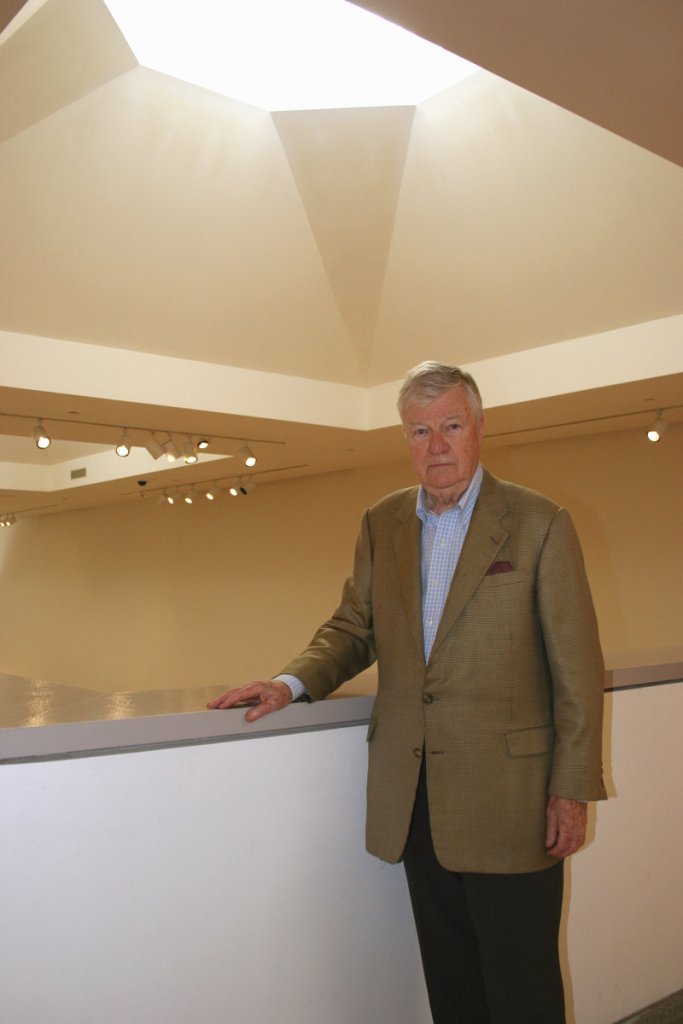PORTLAND – Henry Cobb strode purposefully and slowly up the stairs from the second floor to the third floor of the Portland Museum of Art. He paused, turned, and walked back down with equally measured steps.
As he walked, Cobb explained the mathematics of the rise and depth of the treads and the purpose of each landing with large windows that look out over the courtyard and into the city below.
“These stairs were designed to walk up and to walk down,” said Cobb, the architect who designed the Payson Wing of the building, which opened in May 1983. “How to entice people up became primary in our design. We wanted the museum to connect to the city, and we wanted people as they move through the museum to be able to look out. The higher you go, you can see the water.”
Facing west, you can also see the White Mountains of New Hampshire from a third-floor window.
Cobb planned every detail — every window, every stair, every skylight, every gallery — with the city and the region in mind. He wanted museum visitors to know they were in Portland, in Maine and in New England.
He wanted the building to connect people to the art in the galleries and to the place on the outside.
Cobb returns to the PMA once or twice a year. He was back on Thursday to receive an award from the Portland Society of Architects and present a lecture in the museum auditorium.
He strolled through most of the galleries, soaking up the art and the experience as a first-time visitor might. But the museum staff treated Cobb as a VIP — and well it should. Without Cobb’s design, the PMA would not be what it is today.
“Every time I walk in here, I get a thrill anew,” said Rosalyne Bernstein, a trustee who has been active at the museum since the 1960s and co-chaired the effort to raise the money to build the Payson Wing.
Cobb got a private tour of the John Marin show, which opens to the public later this week. He told museum director Mark Bessire he thought the Marin exhibition was “spectacular,” and saluted him for his stewardship of the building.
Cobb paused his private tour on the third floor to discuss the building and its legacy.
“After the museum opened, the comment that pleased me the most was the comment of a grandmother who said she liked to bring her grandchildren up here because the children said they felt it was like exploring grandma’s attic,” Cobb said.
Now 28 years later, he remains pleased with the Payson Wing and is gratified that the building has become a regional landmark. He is especially happy that the museum’s McLellan House and Sweat galleries have been restored and reopened to the public.
He’s also looking forward to the day when the Clapp House on Spring Street, tucked in behind the museum, receives attention from the PMA and is added to the museum’s exhibition repertoire.
The Payson Wing was never intended as a stand-alone building, he explained. As time moves on, the museum campus more closely resembles Cobb’s long-term vision. Among the buildings, the museum is able to showcase two centuries of architectural history, he said.
“This building is an addition. It was always intended to work with the other buildings and the grounds,” Cobb said. “The gardens and the trees were integral to the design.”
A widely honored and decorated architect, Cobb has designed buildings across the United States and internationally. He is among the most important architects of his generation.
Cobb is from Boston, but has roots in Portland. He worked hard to earn the commission to design the Payson Wing, and left much of his personality in its design.
His great-great-great-grandfather lived in a house that stood on the site of the present museum. The family home was taken down in 1897 to make way for commercial development, which in turn gave way to the museum we know today.
Thus, the Portland museum has always held special meaning to Cobb. He does not claim inspiration from his family home, although his great-great-great-grandfather was on his mind during the design and construction.
“It inspired me to look for a silver spoon or something when they were excavating,” he said with a laugh. “But nothing showed up.”
Cobb’s only complaint about the building is the current use of the many skylights, which remain a key architectural element. For many years now, because of concerns about natural light and its harmful impact on works on paper, the museum has shuttered the skylights from the outside.
Cobb designed some galleries with natural light and others without it. He would like museum curators to plan exhibitions so that the delicate art is situated in galleries without natural light. He wants the shutters removed so natural light can stream in and “bring the building to life.”
He called the shuttered skylights his “pet peeve,” and did not hesitate telling Bessire as much when they walked through the galleries.
But other than that, he is happy with the building and is always glad to come back.
“The building, if I may say so, it very well detailed and very well built.”
Staff Writer Bob Keyes can be contacted at 791-6457 or at:
bkeyes@pressherald.com
Follow him on Twitter at:
twitter.com/pphbkeyes
Send questions/comments to the editors.



